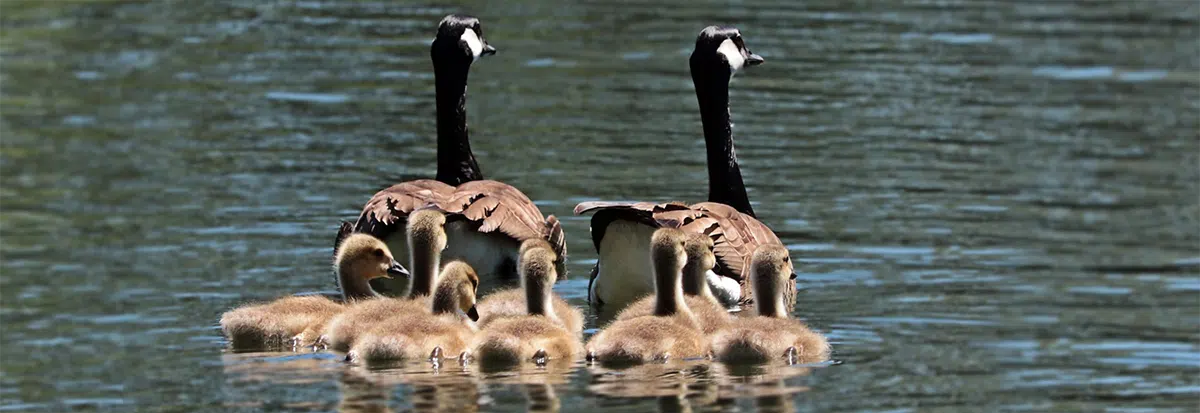Canada Geese, while a familiar and somewhat nostalgic sight, do cause a fair bit of headache and damage in urban, suburban, and rural areas. If you are seeking solutions to mitigate geese, we should talk about whether you want to control geese or remove them. Join us as we explore the diffrences.

Deciding Between Goose Control and Goose Removal
- Goose Control and Goose Removal are terms that are sometimes used interchangeably, but they are actually two very different approaches to wildlife management.
- Knowing the difference can help you choose the right strategy for your goose related problems.
- Do you want to manage the population of geese on your property or remove them altogether?
- Are the geese an occasional nuisance during migration or for a few weeks in the summer months? OR - Do the geese cause significant damage to your property or pose a health risk to people or pets?
- Both goose control and goose removal require permits from the government. The Canada Goose is protected under the Migratory Bird Treaty Act, which is an agreement between many countries around the world.
What IsThe Difference Between Goose Control And Goose Removal?
The difference is the objective. Do you want to manage the population (the numbers) of geese or do you want all of them to move on to somewhere else? Geese Control attempts to limit or maintain the number of geese while Geese Removal moves the flock off of a property. Let's look at how this can be accomplished:
 Goose Control
Goose Control
Geese control uses a variety of methods and techniques to manage and reduce the numbers of geese in a particular space without actually removing them entirely from the area. This is usually done to minimize any negative impact the geese have on an environment and to reduce any possible health risks to humans from the goose droppings. Geese love to eat tender new grasses, so they love parks, golf courses, any lawns or green spaces where the grass is kept short. Overgrazing by geese can eventually kill the grass and any tender young vegetation near the grass.
Tried and true methods of geese control include:
Habitat Modification
Habitat modification means altering the environment to make it less appealing to the geese. This includes using tall vegetation - geese like short grasses so they can observe predators approaching, and because short grass allows for easier detection of tender new shoots to eat.
Visual and Audio Deterrents
Visual deterrents are often used - like scarecrows, reflective tape that moves in the wind, predator decoys. Auditory deterrents can include air horns, pyrotechnics or loudspeakers that broadcast distress call or predator sounds.
Falconry
Falconry offers a non-lethal, natural, and humane way to make geese move on. A bird of prey in the air signals that the area is no longer safe or comfortable. Falconry for bird abatement can be extremely effective with the right falconer and the right bird of prey. Eagles are the raptor of choice as they are large enough to easily take down a goose, making it most effective for scaring geese away.
Lasers
Lasers can be particularly effective as geese are very sensitive to bright lights, especially at dusk or dawn when the geese are more active. Lasers can be large programmable systems that can cover large areas - such as airports, or they can be small, handheld devices that can follow and track a goose to scare it away. 3B Lasers used in Canada for bird control need government issued permits for use.
Dogs
Dogs are very effective at chasing geese out of areas they are unwanted. Geese see dogs as predators and will avoid areas where they’ve encountered them. Regular maintenance with dogs is necessary to keep geese from returning.
Chemical Repellents
Chemical repellents are frequently used to repel geese as the chemicals make any vegetation unappetizing to geese. The products contain ingredients that are unpleasant to geese but will not harm humans, their pets, or the environment. Chemicals need to be reapplied regularly, especially after a rainfall.
Egg Oiling
Egg oiling or addling is only included in this list as a last resort. Putting oil on the egg or shaking it will prevent the egg from ever hatching but will not prevent the geese from staying on the nest to protect it. Geese can be very aggressive to protect the nest.
Goose Removal
Goose removal involves physical removal of geese from the area altogether. This approach is often used when the presence of geese becomes a problem that cannot be solved by control measures alone. Either, the numbers of geese are becoming a significant threat to humans or their droppings now pose a health risk because of the diseases present in the droppings (bacterial, fungal, parasitic and sometimes viral). Feathers can also carry disease.
Goose Trapping and Relocation
Trapping and relocation is typically the number one choice for people in that it sounds more humane. This is not always a good solution as the geese often return to their original habitats because they have strong homing instincts. There is also the possibility of moving diseased birds from one area to another and spreading disease in the new location.
 Goose Nest Removal
Goose Nest Removal
Nest removal includes taking the nests and the eggs away in order to disrupt the breeding cycle of the geese. Other control methods are still needed to prevent the geese from making new nests and laying new eggs. The geese will quickly realize it is unsafe for them to nest here.
Lethal Removal of Geese
Lethal removal is usually necessary when the geese pose a serious risk to human health and safety - such as near Airports. This involves the culling of geese populations to reduce numbers. Several years ago Hawkeye Bird And Animal Control was contacted about geese removal for a large public park that had several hundred geese daily. It was a health hazard with all the droppings and the geese were aggressive towards people and their pets. The proper permits were received from the government. It was the summer and the geese were moulting (dropping their flight feathers to grow new feathers). Hawkeye herded the geese with the assistance of dogs into a penned area. They were then shipped out to a poultry processing plant. The geese were processed and given to several charity organizations to feed homeless people and those less fortunate.
Both Goose control and removal require permits from the government as geese are protected under the Migratory Bird Treaty Act. Professional wildlife control technicians have to necessary skills and experience to assist you in choosing which strategies are best for your situation. The primary objective of goose control is to control the numbers of geese in an area of concern. Whereas the objective of removal is to permanently remove geese from the area. Monitoring and control will still be needed after the geese are removed to prevent new geese from moving into the area in the future. Goose control is an ongoing necessity needing maintenance and monitoring to ensure effectiveness and indicators for a change in strategies.
Call Hawkeye for Professional Geese Control and Removal
Hawkeye Bird & Animal Control is your go-to Bird Control Company to assist you in deciding whether to control or remove geese and which strategies are best for your situation. Hawkeye has the professionals with the knowledge, skills and expertise to handle any bird control problemm, including trained falconers and eagles. We also have the nicest dogs who love to chase geese away from your property. Contact Hawkeye today for your Goose Control and Removal needs.














